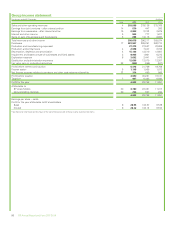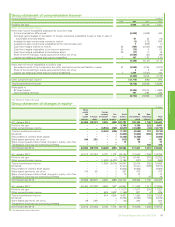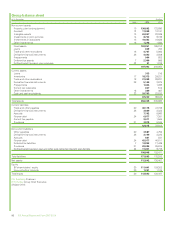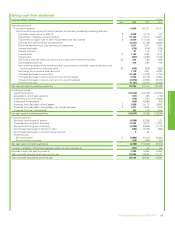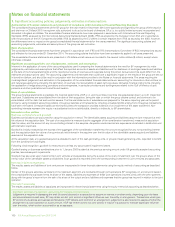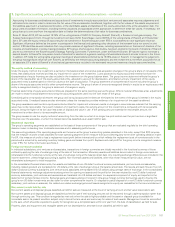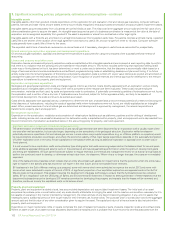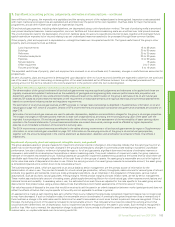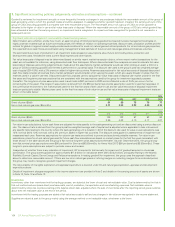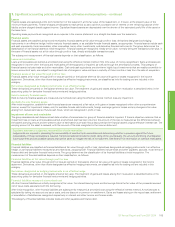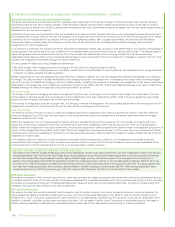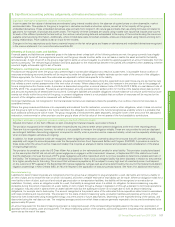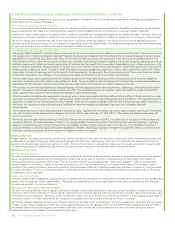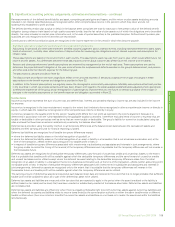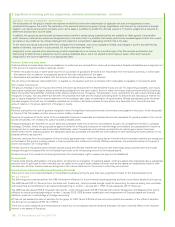BP 2014 Annual Report Download - page 110
Download and view the complete annual report
Please find page 110 of the 2014 BP annual report below. You can navigate through the pages in the report by either clicking on the pages listed below, or by using the keyword search tool below to find specific information within the annual report.
1. Significant accounting policies, judgements, estimates and assumptions – continued
Derivative financial instruments and hedging activities
The group uses derivative financial instruments to manage certain exposures to fluctuations in foreign currency exchange rates, interest rates and
commodity prices as well as for trading purposes. These derivative financial instruments are initially recognized at fair value on the date on which a
derivative contract is entered into and are subsequently remeasured at fair value. Derivatives are carried as assets when the fair value is positive and as
liabilities when the fair value is negative.
Contracts to buy or sell a non-financial item that can be settled net in cash or another financial instrument, or by exchanging financial instruments asif
the contracts were financial instruments, with the exception of contracts that were entered into and continue to be held for the purpose of the receipt
or delivery of a non-financial item in accordance with the group’s expected purchase, sale or usage requirements, are accounted for as financial
instruments. Gains or losses arising from changes in the fair value of derivatives that are not designated as effective hedging instruments are
recognized in the income statement.
If, at inception of a contract, the valuation cannot be supported by observable market data, any gain or loss determined by the valuation methodology is
not recognized in the income statement but is deferred on the balance sheet and is commonly known as ‘day-one profit or loss’. This deferred gain or
loss is recognized in the income statement over the life of the contract until substantially all the remaining contract term can be valued using
observable market data at which point any remaining deferred gain or loss is recognized in the income statement. Changes in valuation from the initial
valuation are recognized immediately through the income statement.
For the purpose of hedge accounting, hedges are classified as:
• Fair value hedges when hedging exposure to changes in the fair value of a recognized asset or liability.
• Cash flow hedges when hedging exposure to variability in cash flows that is attributable to either a particular risk associated with a recognized asset
or liability or a highly probable forecast transaction.
Hedge relationships are formally designated and documented at inception, together with the risk management objective and strategy for undertaking
the hedge. The documentation includes identification of the hedging instrument, the hedged item or transaction, the nature of the risk being hedged,
and how the entity will assess the hedging instrument effectiveness in offsetting the exposure to changes in the hedged item’s fair value or cash flows
attributable to the hedged risk. Such hedges are expected at inception to be highly effective in achieving offsetting changes in fair value or cash flows.
Hedges meeting the criteria for hedge accounting are accounted for as follows:
Fair value hedges
The change in fair value of a hedging derivative is recognized in profit or loss. The change in the fair value of the hedged item attributable to the risk
being hedged is recorded as part of the carrying value of the hedged item and is also recognized in profit or loss. The group applies fair value hedge
accounting when hedging interest rate risk on fixed rate borrowings.
If the criteria for hedge accounting are no longer met, or if the group revokes the designation, the accumulated adjustment to the carrying amount of a
hedged item at such time is then amortized to profit or loss over the remaining period to maturity.
Cash flow hedges
The effective portion of the gain or loss on a cash flow hedging instrument is recognized within other comprehensive income, while the ineffective
portion is recognized in profit or loss. Amounts taken to other comprehensive income are reclassified to the income statement when the hedged
transaction affects profit or loss.
Where the hedged item is a non-financial asset or liability, such as a forecast foreign currency transaction for the purchase of property, plant and
equipment, the amounts recognized within other comprehensive income are reclassified to the initial carrying amount of the non-financial asset or
liability. Where the hedged item is an equity investment, the amounts recognized in other comprehensive income remain in the separate component of
equity until the hedged cash flows affect profit or loss. Where the hedged item is recognized directly in profit or loss, the amounts recognized in other
comprehensive income are reclassified to production and manufacturing expenses, except for cash flow hedges of variable interest rate risk which are
reclassified to finance costs.
If the hedging instrument expires or is sold, terminated or exercised without replacement or rollover, or if its designation as a hedge is revoked,
amounts previously recognized within other comprehensive income remain in equity until the forecast transaction occurs and are reclassified to the
income statement or to the initial carrying amount of a non-financial asset or liability as above.
Significant estimate or judgement: application of hedge accounting
The decision as to whether to apply hedge accounting within subsidiaries, and by equity-accounted entities, can have a significant impact on the group’s
financial statements. Cash flow and fair value hedge accounting is applied to certain finance debt-related instruments in the normal course of business
and cash flow hedge accounting is applied to certain highly probable foreign currency transactions as part of the management of currency risk. In
addition, the financial statements reflect the application of cash flow hedge accounting to certain of the contracts signed in October 2012 for BP to sell
its investment in TNK-BP and obtain an additional shareholding in Rosneft, which were accounted for as derivatives under IFRS. The group applied ‘all-in-
one’ cash flow hedge accounting to the contracts to acquire shares in Rosneft, resulting in a pre-tax loss of $2,061 million being recognized in other
comprehensive income in 2013 and a pre-tax gain of $1,410 million in 2012. See Note 15, Note 27, and Note 28 for further details.
Embedded derivatives
Derivatives embedded in other financial instruments or other host contracts are treated as separate derivatives when their risks and characteristics are
not closely related to those of the host contract. Contracts are assessed for embedded derivatives when the group becomes a party to them, including
at the date of a business combination. Embedded derivatives are measured at fair value at each balance sheet date. Any gains or losses arising from
changes in fair value are taken directly to the income statement.
Fair value measurement
Fair value is the price that would be received to sell an asset or paid to transfer a liability in an orderly transaction between market participants. The
group categorizes assets and liabilities measured at fair value into one of three levels depending on the ability to observe inputs employed in their
measurement. Level 1 inputs are quoted prices in active markets for identical assets or liabilities. Level 2 inputs are inputs that are observable, either
directly or indirectly, other than quoted prices included within level 1 for the asset or liability. Level 3 inputs are unobservable inputs for the asset or
liability reflecting significant modifications to observable related market data or BP’s assumptions about pricing by market participants.
106 BP Annual Report and Form 20-F 2014


